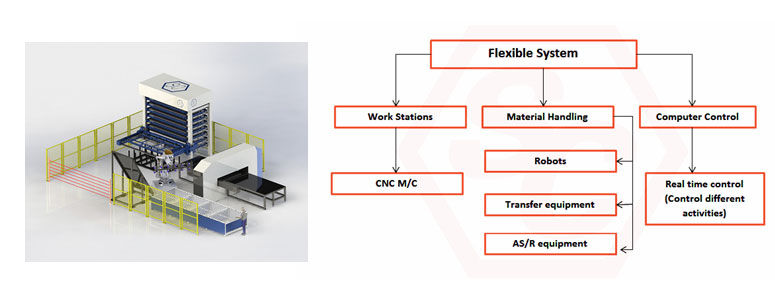
It explains what Flexible Manufacturing System (FMS) is an engineering manufacturing system that allows flexible and automated production due to predictable or unpredictable changes in the industry. It is mainly based on machining or manufacturing industries and has a wide range of applications, including process and assembly, machines and some automated tasks.
These systems can achieve varying degrees of flexibility, which are completely related to the components of the system. The system is often used in manufacturing parts and product combination factories that require mass production and high variability.
The main feature is that if the product type is changed during the production process, the production machinery does not need to be replaced frequently. It can be achieved as long as the computerized industrial control system is modified to meet the rapid changes in market products and achieve a variety of customer demand for customized and low-volume production products.

In short, it is a manufacturing system that uses computers to arrange machinery to achieve automatic processing lines. A set of production system can be customized by users or developers, mainly using computer-controlled machine tools, supplemented by production assembly equipment, robotic hands, quality inspection machines, automatic optical inspection and other equipment, and computer integrated manufacturing (CIM) material handling And storage system.

The flexibility is usually divided into two categories, as follows:
The first category is “machine flexibility”, which covers the resilience of the system to manufacture new products and the resilience due to changes in component processes.
The second category is “use flexibility” using different types of machinery and equipment to run the same components in the same process, as if a manufacturing system absorbs large-scale changes such as production batch size, capacity, and productivity.
You may also want to learn more about Types of Industrial Robots in Sheet Metal Automation
Most flexible manufacturing systems also have three main systems, which combine various distributed data processing, automated logistics, and integrated material processing industrial manufacturing systems.
Usually several automated CNC machine tools are used as working machines, and they are connected with material conveying systems such as conveyor belts and manipulators to optimize the component process and the central control computer to control the material transportation and mechanical processes.
“Flexible manufacturing system sending data” contains most of the short-term news from workstation nodes, equipment and instruments, and large amounts of documents required by the system. The message size ranges from a few number tuples to hundreds of bytes.
Operating software and other data such as those recorded in large-scale files, data at the processing stage, data communicated with operating instruments, data on monitoring status, and data reported from small workstations (like robotic bending cell), etc.
The return time is also somewhat different. It usually takes about 60 seconds to download a large amount of program files from the main computer to each instrument or workstation node starting from the flexible manufacturing system.
Instrument information needs to be submitted within a certain period of deterministic time delay, and other information types are transported for short-term emergency reporting and transmission and reception of most instant messages.

Reliable FMS protocol to support all FMS features is urgent now. The existing protocols established by the IEEE cannot meet the actual communication needs of the current environment.
CSMA/CD protocol delay refers to when some workstation nodes are not restricted due to increased message collisions. Token Bus has a decisive message delay but cannot give priority to support the access scheme of FMS access scheme.
Token-Ring provides pass priority and low message delay. However, the information sent is not credible. A single node error usually occurs when sending errors through the workstation node. In addition, the token ring topology (a type of physical network architecture) also requires high-level wiring to install the network and cost.
In the early days, factories were mostly labor-intensive industries due to low labor costs. The factory machinery and equipment were mainly manual operation and traditional special machines.
Beginning in the second half of the 1960s, industrial production plants needed low production costs and shortened delivery times so that they could achieve diversified changes and meet the trend of diversified customer requirements for products.
Therefore, in order to meet this requirement, a production system suitable for many types and low-volume production is needed.

Advantages:
The main advantage is the high flexibility of managing manufacturing resources (such as the manufacturing time and management of investing in research and development of new products).
The best application of the FMS is small batch production like mass production. Its advantages are faster and lower unit production cost, better human productivity and machine efficiency, quality improvement, increase system reliability, reduce component inventory and computer-aided design and manufacturing (CAD/CAM) operation adaptability.

Disadvantages:
But the disadvantage is that the introduction phase requires a certain amount of time, technology and cost to construct the system, especially for large FA factories.
After the system is operated, the production time of the most effective products is 1/3 of the previous. And the operator is also reduced by 1/5. Such a large-scale automated production equipment, in addition to the cost of construction, also needs to invest in more matching sub-systems and accumulated inherent technology. It is definitely not achieved overnight.
Click here to know: MES System Production Management Functions